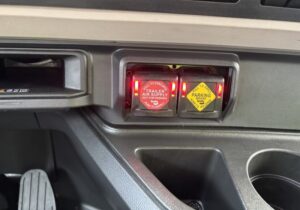Your brakes may be a problem.
In fact, Commercial Vehicle Safety Alliance (CVSA) inspectors placed 19% of vehicles inspected out of service (OOS) during the three-day 2023 International Roadcheck.
More than 11,270 vehicles were placed OOS and more than 2,800 of them were for brakes. OOS brake violations were found in about 7.4% of vehicles inspected.
Roadcheck is not a surprise inspection.
CVSA publishes inspection dates months in advance and specifies the areas the inspectors will focus on. Drivers knew, or should have known, that inspections were taking place, yet many of them failed for items that could have been identified in a thorough pre-trip inspection.
Drivers should not have known about CVSA’s unannounced Brake Safety Day, held on June 10 this year. In that event, inspectors found OOS brake violations in 11.6% of the vehicles inspected. Of those, nearly 58% failed due to brake violations on 20% or more of their brakes.
A vehicle with five axles has 10 braking units, two per axle, so the 20% rule means that at least two of the brakes didn’t operate properly.
Another annual CVSA event is Brake Safety Week, which is publicized well in advance. This year’s event is scheduled for Aug. 25-31. In last year’s event, held Aug. 20-26, 12.6% of the vehicles inspected had OOS brake violations.
Brake violations can include broken brake drums, cracked innings, out-of-adjustment and contamination. The latter usually occurs when a leaking wheel seal results in oil on the drums / pads. Worn out or even missing linings are also common issues.
The vehicles that are inspected aren’t always chosen randomly, so the results can’t be fairly applied to all trucks on the road. In other words, finding that 12.6% of the vehicles inspected had OOS brake conditions does not mean that 12.6% of all trucks have those conditions.
Still, the numbers are alarming — and most are preventable.
Drivers may correctly point out that brakes are difficult to check. Access panels make it difficult to see linings and drum conditions, and most drivers don’t even know what the push-rod travel measurement should be for the vehicles they drive.
But identifying axle oil running down the inside of a tire doesn’t take a degree from technical school. Neither does finding broken or missing parts, chafing hoses or ABS lights that stay lit or listening for air leaks.
Consider that, in the 2023 Roadcheck, 19.3% of vehicles placed OOS were failed for tires. Nearly one in five OOS violations were for tire issues that could have easily been identified had the driver inspected the vehicle properly.
The days of drivers crawling under trucks and trailers to manually adjust slack adjusters are, for the most part, long gone. The prevalence of disc brakes has eliminated slack adjusters from the inspection process on some trucks. But with months of advance notice for inspection events, it seems like drivers and carriers would work to get vehicles in the shop for inspection and repair of items the driver can’t inspect easily.
In-cab checks to see if the vehicle’s air system is leaking and verify that warnings and protection valve closings are working properly aren’t difficult to do. Automatic slack adjusters have relieved the driver of the task of adjusting brakes, but not the responsibility of making sure they are in adjustment.
Unfortunately, most drivers aren’t taught how to do this.
When inspectors check brake adjustment, they generally use an “applied stroke” technique. Any driver who has had to sit in the driver’s seat, listening for an inspector’s instruction to step on the brake pedal, has participated in this test. The inspector simply measures how far the push rod travels when the brakes are applied. The allowed travel for an automatic adjuster is, for most applications, two inches.
To use the applied brake method yourself, it’s critical that you chock the wheels of the vehicle because the spring brakes must be off to measure push rod travel. You can use a chalk marker to indicate the start position of the push rod, or purchase widely available plastic rings that slip onto the push rod. A trick some drivers use is to place a plastic zip-tie on the push rod, up against the chamber.
Have a friend or coworker step on the brakes while you measure, or use a stick or other device to hold the brake pedal down. If the push rod travel is close to or more than the two-inch limit, three or four hard applications of the service brakes should be enough to cause the slack adjuster to tighten up the push rod travel. Then, measure again.
The pry bar method also requires the spring brakes to be off and the wheels chocked and can be done without assistance. Simply insert a pry bar, large screwdriver or whatever you’re using near the clevis pin where the slack adjuster meets the push rod and pry it outward.
In general, it should be about one-half to three-quarters of an inch or about the width of the average sized thumbnail.
Manufacturers of automatic slack adjusters advise replacing them if they get out of adjustment rather than trying to adjust them manually. The tests will help you determine if your brakes need attention before the next CVSA inspection event. There are numerous YouTube videos that show both methods of checking adjustment.
Steer axle brakes should apply evenly. If the truck pulls to one side or the other while braking, have the brakes checked out. Disc brakes don’t have push rods, but can still be inspected for cracked rotors or pads and contamination.
By carefully inspecting your vehicle, performing in-cab checks and checking the adjustment of slack adjusters, if so equipped, you can greatly increase your chances of passing an official vehicle inspection and help yourself to stay safe, too.
Cliff Abbott is an experienced commercial vehicle driver and owner-operator who still holds a CDL in his home state of Alabama. In nearly 40 years in trucking, he’s been an instructor and trainer and has managed safety and recruiting operations for several carriers. Having never lost his love of the road, Cliff has written a book and hundreds of songs and has been writing for The Trucker for more than a decade.














